Wagashi Competition Chado Urasenke Iemoto Award
| March 31, 2017, at the Nagoya Humanitec Confectionery College located in Nagoya City, a wagashi-making competition took place as a part of the 27th National Confectionery Exposition in Mie. The 51 contestants were vying to win the Chado Urasenke Iemoto Award, a special award offered this year to encourage wagashi craftsmenship and nurture young craftsmen. The National Confectionery Exposition (Zenkoku Kashi Daihakurankai) is a fair sponsored once every four years by the All Japan Association of Confectionery Manufacturers. Having its beginnings in 1911 as the Grand Imperial Confections and Candy Fair, the exhibition today is a showplace for the wide variety of newly-developed confections, snack foods, and sweets described as kashi/okashi in Japanese. A highlight is the program for professional makers of Japanese or Western style confections to enter their creations and win an award: the coveted Imperial family's President's Award, the Minister of Agriculture's Award, or the Minister of Culture, Sports, Science, and Technology's Recognition. To this was added a special competition this year, for the Chado Urasenke Iemoto Award. The final judges for this included (from the right in the photo below) SEN Takafumi and IZUMI Reijiro from the Urasenke head family, Konnichian deputy tea masters KURAKAZU Sokaku and NARA Sokyu, and Urasenke distinguished master (meiyo shihan) ASANUMA Sohaku. |
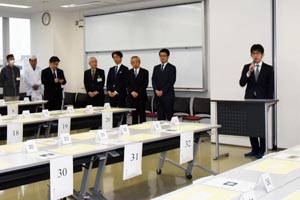 |
| SEN Takafumi, representing Urasenke, headed the judges' committee, and at 9:00 A.M. gave an opening address. The competition rules were explained, and then the competitors set to work on making the wagashi they each had designed and entered, on the set theme of "the spirit of eternal youth" — "eternal youth" (tokowaka) being associated with the Grand Ise Shrine located in Mie, which is rebuilt every twenty years, based on the idea that through constant regeneration and renewal the gods and the nation can remain eternally young and vigorous. |
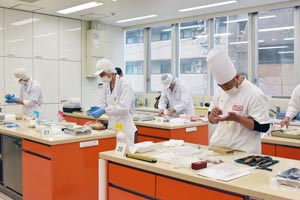 |
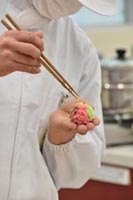 |
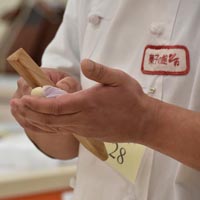 |
| From the afternoon, a preliminary judging was conducted by 50 Urasenke chado teachers of the Tokai Region (roughly Shizuoka, Aichi, Gifu, and Mie prefectures), to decide the top 8 entries. There were three aspects to judge: 1) first impression, 2) expression, and 3) taste. |
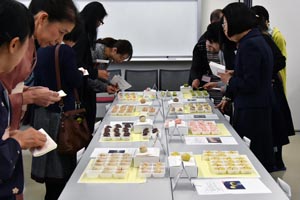 |
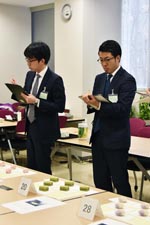 |
| The panel of final judges then met the creators of the 8 entries and listened to each explain about his creation. After that, the final judges carefully considered the 8 entries. This resulted in their selection of the wagashi named "Wajin" (Japan's gods), by TONE Takeshi of the Tone Kashikan confectionery shop in Mie, as winner of the Grand Prize. According to Tone, the image he strove to express was of a god’s halation. The "Minamo" (water's surface), by WATANABE Kazuyoshi of the Suzume-odori-Honpo wagashi shop in Nagoya, and "Yuzuriha" ("yielding leaf," the Japanese name for the daphniphyllum plant), by YAMAMOTO Takahiro of the Tamaiya-Honpo wagashi shop of Gifu, tied for the Award of Excellence. Watanabe said of his "Minamo" that he designed it on the idea that a circle represents the wellspring of everything and stands for eternal beauty. Yamamoto chose the "Yuzuriha" as his image because the old leaves' way of yielding to the newly sprouted leaves makes this plant appear always refreshed. |
| Grand Prize |
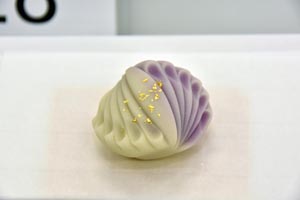 |
| "Wajin" |
| Award of Excellence | |
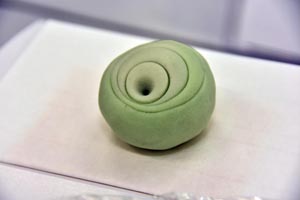 |
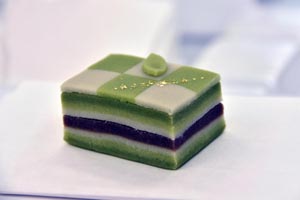 |
| "Minamo" | "Yuzuriha" |
| The five runner-up entries were as follows: "Tokowaka-no-bi" (the beauty of eternal youth), made by SAKAGUCHI Takahiro of Aichi using the variety of Japanese yam peculiar to Ise; "Tokowaka–San'yu" (constant renewal, three mates), by NAKATA Masatoshi of Shiga, based on his notion that a continuing series of three mates successively twenty years apart in age could successfully keep their tradition alive forever; "Hanakaze" (a breeze blowing the flowers), by TANAKA Shoichi of Mie, on the image of the eternally changing seasons; "Tokijiku-no-kagu-no-konomi" (the "timeless, fragrant tree-fruit," referring to the legendary original kashi), by GOTO Toyomasa of Aichi; and "Tokowaka-no-ibuki" (a breath of eternal youth), expressing the atmosphere of the Grand Ise Shrine, by SAIKI Yoshihito of Hyogo. |
| Runner-up Entries | ||
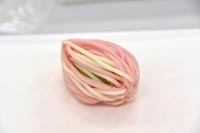 |
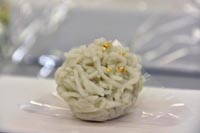 |
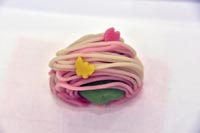 |
| “Tokowaka-ni-bi” | "Tokowaka–San'yu" | "Hanakaze" |
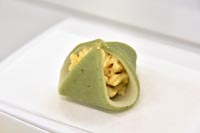 |
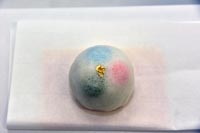 |
| "Tokijiku-no-kagu-no-konomi" | "Tokowaka-no-ibuki" |
| HOME |